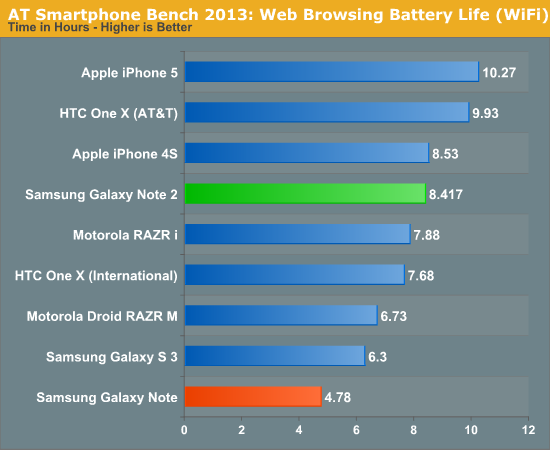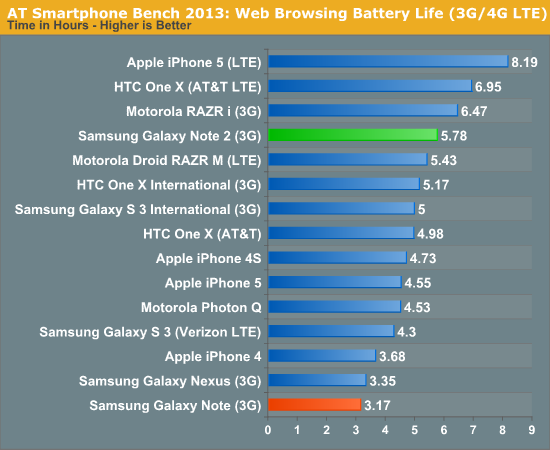Samsung Galaxy Note 2 Review (T-Mobile) - The Phablet Returns
by Brian Klug on October 24, 2012 9:00 AM ESTBattery life testing is usually the single most time-consuming part of smartphone reviews at the moment. As noted in the iPhone 5 review, we’ve changed up our battery life test completely based on what we learned from both previous versions and to help get some aspects under control where OEMs were doing aggressive caching even when they weren’t supposed to. The result is this new test which we feel is pretty balanced but still challenging enough to be relevant for a while.
The basic overview is the same as the previous test — we load webpages at a fixed interval until the handset dies, with display set at exactly 200 nits as always. The test is performed over both cellular data and WiFi. The new test has decreased pause time between web page loads and a number of JavaScript-heavy pages. I sat down with some UMTS RRC (Radio Resource Control) emulator tools and also made sure we had a good balance of all the RRC states (DCH, PCH if possible, FACH, IDLE) so we weren’t heavily biased towards one mode or the other. There’s a lot that went into this, but again the pretense is the same.
Since I have the T-Mobile version of the Galaxy Note 2 I couldn’t test LTE battery life. However, T-Mobile runs DC-HSPA+ which is two 5 MHz wide WCDMA carriers aggregated together, so the result is a receive path that looks vaguely similar to 10 MHz FDD-LTE with the same wide LNAs lit up. Of course on the transmit side DC-HSPA+ is still just a single WCDMA carrier for uplink. At the same time as we’ve shown in previous testing the LTE battery life with this new generation of handsets is often better than the equivalent on 3G since the handset can get back into an idle radio resource state quicker for the same workload.
Galaxy Note 2 also has a positively gargantuan battery, at 11.8 watt-hours. This is the largest I’ve seen yet in a smartphone. For comparison the previous Galaxy Note shipped a 9.25 watt-hour battery, and Galaxy S 3 went with around an 8 watt-hour battery. Powering all that display definitely requires the biggest electron tank the design and form factor can possibly afford.
I should also mention that I’m running the previous generation Galaxy Note through the new test, but it isn’t complete in time for the review. I’ll add that data in at a later date as soon as it is complete. The same applies to the call test, which is starting to become an unwieldy test at around 12 hours for most new phones. Update: I've added in WiFi and 3G battery life testing results for the AT&T Galaxy Note.
Let’s start with WiFi however, where we let the client decide on either 5 GHz or 2.4 GHz depending on its own priority.

Galaxy Note 2 does pretty well here considering everything it has to deal with, huge battery and the combination of latest WiFi combo chip silicon (still BCM4334) helps the Note 2 last nearly 8.5 hours. This is longer than even the SGS3 in the same test.

On T-Mobile DC-HSPA+ the Note 2 also does pretty well, it’s in the upper third of our results, still above the SGS3, and among other phones I subjectively consider to have great battery life on cellular like the One X (8960). I suspect if I had been able able to get the Note 2 on AT&T LTE (more on that later) we’d see even better run time thanks again to the race to idle advantage that you get with the faster air interface.
My call test isn’t done, but from the data I have already, I would extrapolate out a 15 hour call run time for the Note 2. Coincidentally this is exactly the specced call time. I’m not making a graph based on extrapolated data though, that’ll have to wait for at least one fully completed run without interruption.
Overall the Note 2 has battery life which isn’t compromised by the presence of fast air interfaces or huge AMOLED display, even at 200 nits which is usually a challenge. In my time with the Galaxy Note 2 out and about I wasn’t want for a charger or top up once, even with Dropbox set to auto upload photos as I captured them which usually nukes devices even with the most impressive of stamina. Again I fully expect that the handset on other carriers with LTE will last even longer than the numbers I managed to get out of the Note 2 on T-Mobile DC-HSPA+.











131 Comments
View All Comments
The0ne - Wednesday, October 24, 2012 - link
Don't worry, I'm 40 years old myself and screen specs are very important for me due to my aging eyes. I've since replaced all my LCDs with 30" IPS ones, e-readers and tablets have at least x800 and now this phone if I decide to buy one (if pricing is right).I was glad to read that statement in the review as well. It definitely put a smile onto my face to actually read it and have someone share the perspective. Mind you my eyes aren't too bad being .75 off but it does make a huge difference having a good screen to look at.
jjj - Wednesday, October 24, 2012 - link
Not a fan of the S3 but for some reason i kinda like this one.The weight seems rather high,after all most of the time the phone sits in a pocket,hope they get rid of some layers of glass in future models.Maybe by then we also see Corning's Willow Glass and the flexible Atmel touch sensor (not controller) for a thinner bezel.
It does feel a bit outdated already with quad Krait devices announced and dual core A15 arriving soon hopefully (Gigaom had some numbers for the A15 based Chromebook and they look impressive)
enezneb - Wednesday, October 24, 2012 - link
That 11 million contrast ratio is just amazing; a true testament to the potential of AMOLED.I could forsee Samsung improving their color calibration standards for the next generation of flagships seeing how they're under considerable pressure from the likes of SLCD2 and Apple's retina display. Paired with this new pentile matrix ultra-high ppi displays in the range of 400 may be possible as well (a la SLCD3)
Looks like next year will be another exciting year for mobile display technology once again.
schmitty338 - Wednesday, October 24, 2012 - link
You can change the colour calibration to be more 'natural' in the TouchWiz software ont eh Note II.Also, personally I don't see the need for 'more accurate' colours on a phone. Maybe if you are a pro photog who reviews pics on their phone, but otherwise, I love the colourful pop of AMOLED displays. Even the low res pentile AMOLED of my old galaxy S (original...getting the Note 2 soon) looks great for media. Text, not so much, due to the low res and pentile.
slysly - Wednesday, October 24, 2012 - link
Why would colour accuracy ever not be important? I thought the point of a big phone is to make it easier to consume all sorts of media, from websites to photos to movies. Wouldn't more accurate colours be better for all of these activities? To me, it's a bit like saying, I don't see the need to eat delicious food during lunch, or I don't need to be with a beautiful woman on the weekdays. Why settle for something markedly inferior?Calista - Thursday, October 25, 2012 - link
Is your screen properly colour calibrated? Are your walls painted in a neutral colour to avoid a colour cast? Are your lamps casting a specified type of light and shielded to avoid glare? Do you use high-quality blinds to prevent sunlight?This is only a few of the things to consider when dealing with calibration. And a cellphone is unable to deal with any of them unless it stays in the lab.
So for a cellphone the criteria is:
Is it bright enough?
Does it look pleasing to the eye, overly saturated or not?
PeteH - Thursday, October 25, 2012 - link
Eh, depends what you do with it. I can understand wanting an accurate representation of a photo you're taking.And given the option between an accurate display and a less accurate display (all other things being equal) I think most people would opt for the more accurate option. Note that I'm not saying they would choose it as better visually (people seem to be suckers for over saturated displays).
Zink - Wednesday, October 24, 2012 - link
Great review. Just the right amount of detail and I really like your perspective on day to day use.Mbonus - Wednesday, October 24, 2012 - link
Battery Life Question: I have noticed that since I have started using audio streaming apps my battery has taken quite a hit. I wonder if that could be added to your battery life benchmarks?It might not matter for devices like this where you have a large storage upgrade ability, but some other devices are forcing us to the cloud where streaming matters.
Great and thorough review as always!
Brian Klug - Wednesday, October 24, 2012 - link
So with streaming apps and such, even though the bitrate is low, if they're not very bursty (eg download and fill a big buffer, then wait 30 seconds or minutes, then repeat) they can hold the phone in CELL_DCH on UMTS or the appropriate equivalent on other air interface types, and that's what really burns power. It's time spent in that connected state that really destroys things.This is actually why I do the tethering test as well (which has a streaming audio component), but I'm beholden to whether or not the review unit that I'm sampled is provisioned for tethering or not, which is the real problem.
-Brian